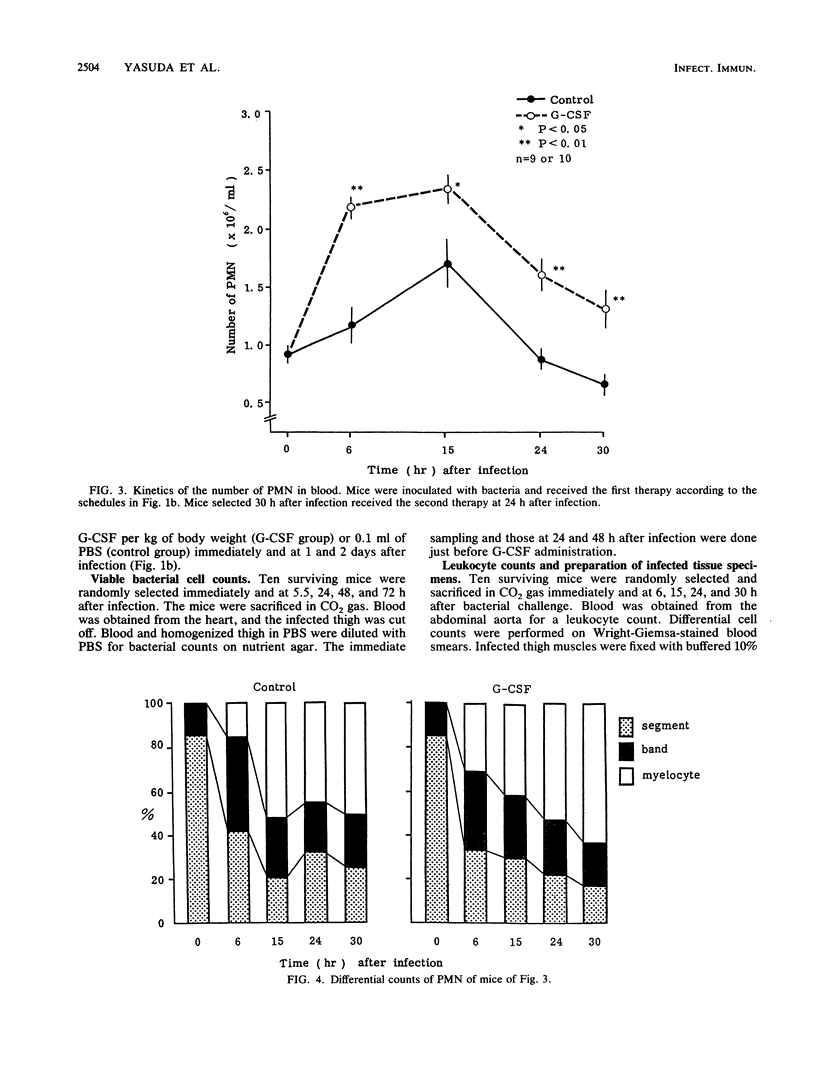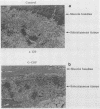Abstract
The therapeutic efficacy of granulocyte colony-stimulating factor (G-CSF) against an experimental intramuscular infection induced by Pseudomonas aeruginosa in mice was confirmed. Bacterial growth in the infected thigh muscle was suppressed by G-CSF treatment. The change in the number of peripheral blood polymorphonuclear leukocytes (PMN) after bacterial challenge was investigated. The results showed that G-CSF could stimulate stronger defense mechanisms after stimulation by bacterial challenge. In the G-CSF-treated group, more clusters of matured PMN were observed in the infected thigh muscle 6 h after bacterial challenge. Next, the correlation between the number of PMN in the blood at the time of infection and the therapeutic efficacy of antibiotics was investigated. The therapeutic efficacy of ceftazidime, a beta-lactam antibiotic, was affected by the number of blood PMN at the time of infection. In particular, a decrease of peripheral blood PMN at the time of infection resulted in a dramatic decrease in the efficacy of ceftazidime. The reduction in leukopenia by G-CSF remarkably strengthened the therapeutic effect of antibiotics in mice.
Full text
PDF







Images in this article
Selected References
These references are in PubMed. This may not be the complete list of references from this article.
- Cohen A. M., Hines D. K., Korach E. S., Ratzkin B. J. In vivo activation of neutrophil function in hamsters by recombinant human granulocyte colony-stimulating factor. Infect Immun. 1988 Nov;56(11):2861–2865. doi: 10.1128/iai.56.11.2861-2865.1988. [DOI] [PMC free article] [PubMed] [Google Scholar]
- Fujisawa M., Kobayashi Y., Okabe T., Takaku F., Komatsu Y., Itoh S. Recombinant human granulocyte colony-stimulating factor induces granulocytosis in vivo. Jpn J Cancer Res. 1986 Sep;77(9):866–869. [PubMed] [Google Scholar]
- Jakubowski A. A., Souza L., Kelly F., Fain K., Budman D., Clarkson B., Bonilla M. A., Moore M. A., Gabrilove J. Effects of human granulocyte colony-stimulating factor in a patient with idiopathic neutropenia. N Engl J Med. 1989 Jan 5;320(1):38–42. doi: 10.1056/NEJM198901053200107. [DOI] [PubMed] [Google Scholar]
- Kajigaya S., Suda T., Suda J., Saito M., Miura Y., Iizuka M., Kobayashi S., Minato N., Sudo T. A recombinant murine granulocyte/macrophage (GM) colony-stimulating factor derived from an inducer T cell line (IH5.5). Functional restriction to GM progenitor cells. J Exp Med. 1986 Oct 1;164(4):1102–1113. doi: 10.1084/jem.164.4.1102. [DOI] [PMC free article] [PubMed] [Google Scholar]
- Matsumoto M., Matsubara S., Matsuno T., Tamura M., Hattori K., Nomura H., Ono M., Yokota T. Protective effect of human granulocyte colony-stimulating factor on microbial infection in neutropenic mice. Infect Immun. 1987 Nov;55(11):2715–2720. doi: 10.1128/iai.55.11.2715-2720.1987. [DOI] [PMC free article] [PubMed] [Google Scholar]
- Mooney D. P., Gamelli R. L., O'Reilly M., Hebert J. C. Recombinant human granulocyte colony-stimulating factor and Pseudomonas burn wound sepsis. Arch Surg. 1988 Nov;123(11):1353–1357. doi: 10.1001/archsurg.1988.01400350067010. [DOI] [PubMed] [Google Scholar]
- Morstyn G., Campbell L., Souza L. M., Alton N. K., Keech J., Green M., Sheridan W., Metcalf D., Fox R. Effect of granulocyte colony stimulating factor on neutropenia induced by cytotoxic chemotherapy. Lancet. 1988 Mar 26;1(8587):667–672. doi: 10.1016/s0140-6736(88)91475-4. [DOI] [PubMed] [Google Scholar]
- Nagata S., Tsuchiya M., Asano S., Kaziro Y., Yamazaki T., Yamamoto O., Hirata Y., Kubota N., Oheda M., Nomura H. Molecular cloning and expression of cDNA for human granulocyte colony-stimulating factor. 1986 Jan 30-Feb 5Nature. 319(6052):415–418. doi: 10.1038/319415a0. [DOI] [PubMed] [Google Scholar]
- Nomura H., Imazeki I., Oheda M., Kubota N., Tamura M., Ono M., Ueyama Y., Asano S. Purification and characterization of human granulocyte colony-stimulating factor (G-CSF). EMBO J. 1986 May;5(5):871–876. doi: 10.1002/j.1460-2075.1986.tb04297.x. [DOI] [PMC free article] [PubMed] [Google Scholar]
- Ohara A., Suda T., Saito M., Miura Y., Okabe T., Takaku F. Effect of recombinant human granulocyte colony-stimulating factor on hemopoietic cells in serum-free culture. Exp Hematol. 1987 Jul;15(6):695–699. [PubMed] [Google Scholar]
- Peterson V., Hansbrough J., Buerk C., Rundus C., Wallner S., Smith H., Robinson W. A. Regulation of granulopoiesis following severe thermal injury. J Trauma. 1983 Jan;23(1):19–24. doi: 10.1097/00005373-198301000-00004. [DOI] [PubMed] [Google Scholar]
- Souza L. M., Boone T. C., Gabrilove J., Lai P. H., Zsebo K. M., Murdock D. C., Chazin V. R., Bruszewski J., Lu H., Chen K. K. Recombinant human granulocyte colony-stimulating factor: effects on normal and leukemic myeloid cells. Science. 1986 Apr 4;232(4746):61–65. doi: 10.1126/science.2420009. [DOI] [PubMed] [Google Scholar]
- Tamura M., Hattori K., Nomura H., Oheda M., Kubota N., Imazeki I., Ono M., Ueyama Y., Nagata S., Shirafuji N. Induction of neutrophilic granulocytosis in mice by administration of purified human native granulocyte colony-stimulating factor (G-CSF). Biochem Biophys Res Commun. 1987 Jan 30;142(2):454–460. doi: 10.1016/0006-291x(87)90296-8. [DOI] [PubMed] [Google Scholar]



